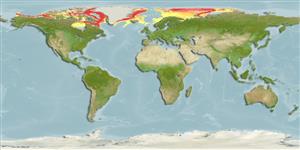Environment: milieu / climate zone / depth range / distribution range
Ecologia
marinhas batidemersal; intervalo de profundidade 50 - 1400 m (Ref. 117245). Deep-water; 80°N - 58°N, 161°W - 104°E (Ref. 117245)
Northeast Atlantic: eastern central Greenland southeast to just north of the Faroes, Jan Mayen Island, around Spitsbergen and northern parts of Barents Sea. Arctic: Franklin Bay, North Western Territory and Alaska (Ref. 11976); also the Kara and Beaufort seas.
Tamanho / Peso / Idade
Maturity: Lm ? range ? - ? cm
Max length : 51.7 cm TL macho/indeterminado; (Ref. 11976)
Descrição breve
Morfologia | Morfometria
Vértebras: 96. Pelvic fins small (Ref. 4695). Uniformly or mostly dark, with 5-8 short, light cross-bands; band across nape, if present, straight, not curved forward; peritoneum dark, with dense brownish-black dots (Ref. 4695).
Found on muddy bottoms (Ref. 4695). Benthic (Ref. 58426). Feeds mainly on epibenthic animals. With increase in size, shrimps and euphausiids are ingested in greater quantities but unlike L. reticulatus, its ingestion of smaller prey items does not decrease. Changes in feeding habit with size are relatively small (Ref. 13532).
Life cycle and mating behavior
Maturidade | Reprodução | Desova | Ovos | Fecundidade | Larvas
McAllister, D.E., M.E. Anderson and J.G. Hunter, 1981. Deep-water eelpouts, Zoarcidae, from Arctic Canada and Alaska. Can. J. Fish. Aquat. Sci. 38(7):821-839. (Ref. 11976)
Categoria na Lista Vermelha da IUCN (Ref. 130435)
Ameaça para o homem
Harmless
Utilização humana
Mais informação
ReferênciasAquaculturaPerfil para aquaculturaEstirpesGenéticaElectrophoresesHereditariedadeDoençasProcessamentoNutrientsMass conversion
ColaboradoresFotografiasStamps, Coins Misc.SonsCiguateraVelocidadeTipo de nataçãoÁrea branquialOutras referênciasCérebrosVisão
Ferramentas
Relatórios especiais
Descarregue XML
Fontes da internet
Estimates based on models
Preferred temperature (Ref.
123201): -0.7 - 2.6, mean 0.4 °C (based on 489 cells).
Phylogenetic diversity index (Ref.
82804): PD
50 = 0.5000 [Uniqueness, from 0.5 = low to 2.0 = high].
Bayesian length-weight: a=0.00275 (0.00171 - 0.00444), b=3.20 (3.06 - 3.34), in cm total length, based on LWR estimates for this species & Genus-body shape (Ref.
93245).
Nível Trófico (Ref.
69278): 3.4 ±0.44 se; based on food items.
Resiliência (Ref.
120179): Muito baixo, tempo mínimo de duplicação da população maior que 14 anos (Preliminary K or Fecundity.).
Fishing Vulnerability (Ref.
59153): Moderate vulnerability (41 of 100).
